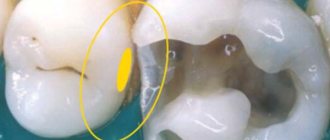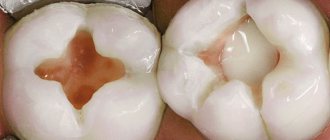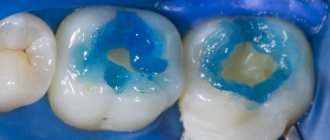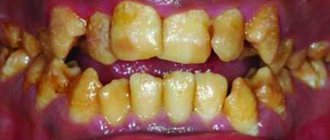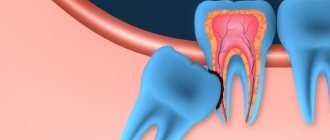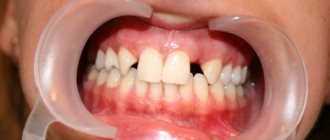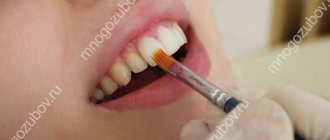2539
Dentists have a large number of different filling materials at their disposal, including the most modern ones.
So it may even seem strange that amalgam, which began to be used more than 200 years ago, is still preferred in some clinical cases. But there are reasons for this.
A little bit of history
Amalgam is the oldest filling material. The first mention of it in this capacity is in ancient Chinese manuscripts. In Europe, amalgam was first used for filling carious cavities by the French dentist Tavean in 1800.
Due to its valuable properties for filling materials - plasticity at room temperature immediately after preparation and subsequent hardening , amalgam was enthusiastically received by dentists. Even the presence of mercury in it did not negatively affect the popularity of the new material.
Despite its “antiquity,” amalgam continues to be used in dentistry today.
The use of the material is considered appropriate for filling fissures and contact surfaces of chewing units (cavities I and II classes according to Black), as well as cervical zones of the vestibular surface of all teeth (V class according to Black).
Links[edit]
- Callister, W.D. "Materials Science and Engineering: An Introduction" 2007, 7th edition, John Wiley and Sons, Inc., New York, Section 4.3 and Chapter 9.
- https://mine-engineer.com/mining/minproc/MercAmal.htm
- Ham, Peter "Zinc Amalgam" in the e-EROS Encyclopedia of Organic Synthesis Reagents (2001). DOI: 10.1002/047084289X.rz003
- ^ ab E. J. Duwell; N. C. Baenziger (1955). "Crystal structures of KHg and KHg2". Acta Crystallogr
.
8
(11): 705–710. DOI: 10.1107/S0365110X55002168. - Emmanuel I. Troyansky and Meghan Baker "Aluminum Amalgam" in the electronic EROS encyclopedia Reagents for Organic Synthesis 2016, DOI: 10.1002/047084289X.ra076.pub2
- "Die Sendung mit der Maus, Sachgeschichte vom Spiegel" (in German). Archived from the original on April 17, 2009. Retrieved April 24, 2009.
- "Mercury Fusion". mine-engineer.com
. Retrieved April 8, 2022. - webmineral.com/data/Leadamalgam.shtml
- Bharti, Ramesh; Wadhwani, Kulvinder Kaur; Tikku, Asim Prakash; Chandra, Anil (2010). "Dental Amalgam: An Update". Journal of Conservative Dentistry: JCD
.
13
(4): 204–208. DOI: 10.4103/0972-0707.73380. ISSN 0972-0707. PMC 3010024. PMID 21217947. - "EU Mercury Regulation". www.europa.eu
. - "The 'mercury toxicity' scam:: How anti-amalgamation opponents are deceiving people". www.quackwatch.com
. - "Statement on Dental Amalgam". www.ada.org
. - ↑
Mutter, Joachim (January 13, 2011).
“Is dental amalgam safe for humans? Opinion of the scientific committee of the European Commission". Journal of Occupational Medicine and Toxicology
.
6
: 2. doi: 10.1186 / 1745-6673-6-2. PMC 3025977. PMID 21232090. - "EU Mercury Regulation". www.europa.eu
.
Composition and properties of the material
Amalgam is obtained by amalgamation - dissolving metal alloys in liquid mercury to form intermetallic compounds.
Tin and silver, dissolving in mercury, form a plastic mass from which a filling is formed. Subsequently, as free mercury disappears, the amalgam begins to harden.
The hardness required to withstand occlusal loads is achieved in about a day.
Includes:
- Mercury ( Hg). The primary content is 40-53%, after amalgamation and curing - 37-48%.
- Silver ( Ag) – 65-73%. This component is responsible for many of the functions of the material - corrosion resistance, hardness, and the ability to slightly expand in the cavity being processed.
- Tin (S n) – (25-29%). Increases the speed of amalgamation, slows down curing.
- Copper (Cu). Increases strength and promotes a tight fit of the material to the edges of the cavity. The content is 2-6% in silver amalgam, up to 30% in copper amalgam, and up to 37% in high-copper amalgam.
- Zinc ( Zn) – up to 2%. Prevents oxidation, reduces fragility, improves technological properties (increases the plasticity of the material).
Properties of amalgam
- Ready for condensation no later than one and a half minutes from the start of mixing.
- Compression resistance after 60 min. – 60 MPa and above, after 24 hours – 300 MPa and above.
- Elasticity – 50-58 GPa.
- Fluidity – 0±0.2% (after complete curing).
Are these fillings used now or is this an outdated method?
The aesthetics of amalgams have long been considered one of the main disadvantages. Given the aesthetic parameters, their use is currently not indicated on the anterior group. But, despite the difference in color, their use on chewing teeth is quite acceptable. This disadvantage is also eliminated if you use the latest generations of amalgams, which tend not to change the color of the tooth.
Despite the variety of filling compounds, amalgam fillings are still being installed; their demand is explained by their low price and durability. In modern dentistry, their composition is still the same, but with a high copper content.
It is known that all components of the alloy react with each other, forming certain phases. Gamma-2 is a phase that is represented by a compound of tin and mercury. It is the weakest and highly susceptible to corrosion, which can subsequently affect the quality of the filling. In amalgams with a high content of copper component, this phase does not form or eliminates itself when properly mixed and the condensation regime is observed.
Modern alternatives to this type of filling composition are composite reflective materials and glass ionomer cements used for both chewing and anterior teeth.
Kinds
Amalgams are classified by composition (type and quantity of compounds and elements included in it) and morphology (shape and size of particles of metal alloys).
Depending on the composition, amalgam is distinguished:
- silver (copper content less than 6%);
- copper – Cu content – 12-30%;
- high-copper – 32-37%.
Amalgams containing more than 0.01% zinc are called zinc-containing.
Morphology
The packability and required condensation pressure of the material depends on the shape of the alloy particles. It could be:
- chips with a size of 150 microns or more, obtained by grinding a metal alloy on a lathe (amalgam obtained from chips is called needle or regular);
- round-shaped granules (spheres) up to 40 microns in size, obtained by spraying a molten alloy in an inert gas (amalgam prepared from such particles is called spherical);
- composition of chips and granules (mixed amalgam).
Condensation of a needle-shaped mixture requires more effort than a spherical mixture.
Development time
Depending on the time of development and use, all amalgams are usually divided into materials of the 1st, 2nd and 3rd generation.
- 1st generation formulations include silver amalgams with low copper content.
- 2nd – materials with a high copper content.
- 3rd – materials containing atomic copper.
Root canal irrigation protocol and instrumentation used.
Read here about the features of vertical condensation of gutta-percha.
At this address https://www.vash-dentist.ru/lechenie/zubyi/plombyi/profaylyi-v-stomatologii.html we offer detailed instructions on the use of profiles in dentistry.
Amalgam in dentistry
Amalgam is a well-known filling material used in dental practice and is highly durable. Its properties are associated with the presence of a number of metals in the composition, as well as mercury, which in large quantities can harm the human body. Among all filling materials, amalgam is considered the most durable .
Amalgam has been actively used in dentistry for more than 100 years, and during all this time there have been significant changes in the chemical composition of the material. Silver or copper amalgam is used in dental treatment, but in modern dentistry, silver amalgam containing a small amount of copper is used.
Chemical composition
The composition of modern amalgam includes many different elements, due to which the material gets its properties. The main components include:
- silver – protects the material from the negative effects of corrosion, and also increases its strength;
- tin – increases the plasticity of amalgam, thereby inhibiting the hardening process;
- copper – has anti-corrosion and antibacterial properties, which is very important in dentistry;
- zinc - intended to soften the remaining components of the amalgam by increasing their wettability with mercury;
- mercury acts as the main reagent. It causes the appearance of amalgam.
Note! During the formation of an amalgam, the reaction of mercury does not occur with all the particles that are included in the main components, but only with their surface layer. In scientific terminology, the chemical reaction during which amalgam is formed is called mechanochemical synthesis.
Why is mercury added to fillings?
Mercury is needed to dissolve some metals. At the moment there is nothing to replace it. Its effect on the body has not been fully studied. Some experts say that even if there are about 10 fillings in the mouth, they will not affect a person’s health. Others say that one filling can emit harmful fumes.
The American Dental Association confirms the negative effects of mercury. During the research, it was noticed that in some cases, mercury, entering the body along with saliva, caused kidney failure and disorders in the central nervous system. But they claim that these phenomena are rare. The negative effects of mercury are associated with improper mixing and filling, and allergies to mercury. If the whole process is done correctly, then there will be no harm from the amalgam.
Classification
Filling material is classified according to several criteria. For example, based on particle size and shape, amalgam can be:
- spherical;
- traditional;
- mixed.
Depending on the amount of copper included in the material, amalgam can be high or low. In the second case, the alloy is called silver.
The amalgam is also classified by the amount of zinc and can be zinc-containing or completely without zinc in the composition.
If fillings contain zinc even in small quantities, this allows the material to easily take the required shape and fill all microcracks or carious defects on the tooth surface.
Purpose of mercury
Mercury plays a dominant role in amalgam, providing its basic technological and functional properties. Thanks to its presence, immediately after mixing the material becomes plastic, allowing the formation of a filling. Subsequently, it hardens - a set of hardness necessary to absorb the chewing load.
Regarding the toxicity of mercury, many studies have been conducted to determine the dangers of amalgam fillings and mercury vapor to patients and medical personnel.
It was revealed that this danger is real, but it should not be overestimated. A small amount of mercury contained in fillings can penetrate the human body.
But even if there are several fillings, its quantity is so small that it cannot cause significant harm to health. The Hg vapor density above the filling does not reach 0.04 MAC.
Medical personnel working with amalgam and coming into contact with mercury vapor are at much greater risk. However, for them, the threat of mercury intoxication can be minimized by strictly observing the prescribed work rules.
This danger becomes completely negligible when using the most modern form of amalgam - capsule. The use of capsules, in which powder and mercury are in the required ratio, eliminates contact of medical personnel with mercury.
Harm to health
As mentioned earlier, metal fillings are harmful to health, in some cases even more than they are beneficial. This is due to the presence of mercury in the alloy, which, when entering the body, poisons it, especially if there is more than one such filling in the mouth. The main symptoms of this phenomenon are:
In addition, it has not yet been determined how metal fillings will behave if they enter the zone of influence of electromagnetic waves, of which there are a lot in a modern room, especially if there are computers and household appliances there.
It is also worth noting that such a filling protects the tooth from damage only during service. When it is removed, the tooth will certainly die, and the nerve will also need to be removed.
This is interesting: Brown coating on the tongue: what it means, causes, treatment
Such fillings were widely used in the USSR. People took it for granted and did not in any way associate numerous health problems with the metal filling. However, studies and numerous reviews prove a negative effect on the body.
Stages of filling
The process of placing an amalgam filling consists of preparatory and basic work.
Preparatory work
- Teeth cleaning.
- Anesthesia.
- Installation of rubber dam.
- Cavity preparation. The shape is classic, box-shaped, with right angles between the walls and the bottom.
It is advisable to have a greater wall thickness than when filling with composite materials.It is recommended to make a cut along the enamel-dentin border to increase retention. Finishing is performed (removal of the edges of the enamel overhanging the dentin).
- Flushing.
- Drying.
Main works
Gasket application. It is considered necessary due to the increased thermal conductivity of amalgam - in order to avoid temperature sensitivity of the tooth.
Laying can be done with different materials (zinc phosphate cements, compomers, glass ionomers, special varnishes). Thickness – 1-1.5 mm. In case of a deep cavity, it is recommended to apply a calcium-containing pad at the point where the pulp is closest to the pulp.
Mixing amalgam
The composition is mixed manually or mechanically, using electric amalgam mixers. Mixing time depends on the composition, particle shape, and mixing system used, and is 15-60 seconds.
Sealing
The material is applied in small portions with an amalgam gun (canal filler), with each portion being completely condensed before adding a new one. Particular attention is paid to preventing porosity of the filling and removing excess mercury .
Condensation is carried out with a plugger from the center to the walls of the cavity. The required pressure force is 30-40 N. It is necessary to fill the cavity with a slight excess . After filling, preliminary modeling of the tooth surface is performed and excess amalgam is removed.
During the final modeling, dimples and transverse fissures are created. The surface is smoothed with benisher. Occlusion is controlled using occlusion paper.
Grinding and polishing are carried out a day later using carborundum heads, brown and green silicone polishers.
For approximal surfaces, strips or phloxes with polishing paste are used. Polishing is done from the center to the edges of the filling. It is necessary to avoid overheating it to prevent evaporation of mercury, using water cooling if necessary.
Correct closure of a problem cavity has:
- the exact shape of the tooth crown;
- mirror shine;
- absence of a boundary between the material and the tooth.
How much does it cost to install such a filling?
These seals are priced lower than standard reflective composite materials. This is due to the low cost of the metals that are included in the composition. The cost may vary depending on the clinic where the procedure will be performed, on average - from 1500-2000 rubles.
Dental amalgam fillings have a place in modern clinical practice, despite their almost complete replacement by composite restorations. They are widely used abroad and are one of the most popular materials for dental fillings. Their strength and durability can be used for filling the chewing group of teeth, when there is no point in focusing on the aesthetic factor.
There is no clear opinion about the dangers of mercury in the composition, so you need to carefully weigh the pros and cons and consider all alternative options before deciding to install an amalgam filling.
All the pros and cons
Modern amalgams are free from many of the disadvantages of 1st and 2nd generation materials. Among their advantages:
- high ductility with sufficient hardness;
- tight marginal adhesion;
- stability of properties under the influence of oral fluid and hygiene products;
- corrosion resistance;
- low allergenicity;
- inertia regarding tooth shade;
- high bactericidal activity;
- insignificant expansion and shrinkage;
- Duration of maintaining a smooth, shiny surface.
Flaws
- A color different from the color of the tooth enamel (silver). Therefore, from an aesthetic point of view, it is advisable to fill only chewing teeth with amalgam.
- High thermal conductivity. If the lining is missing or insufficiently thick, the teeth may become sensitive to hot and cold.
- Changes in size due to shrinkage and expansion at different stages of filling. For good retention, it is desirable that the material expands slightly at the end of curing.
- The difference in the parameters of thermal expansion of amalgam and dentin (possible destruction of the thin wall of the teeth due to thermal expansion).
- Lack of a chemical bond between the filling and the tooth.
- Presence of toxic mercury.
- The occurrence of electric current (galvanic syndrome) in the presence of metal orthodontic or orthopedic structures in the oral cavity. It manifests itself as a metallic taste in the mouth, a feeling of acidity, and a burning sensation on the tongue.
- The time interval between the formation of the filling and the time of final curing is too long (about a day).
It can be reduced with appropriate additives, but at the cost of reducing working time to 4-5 minutes, which is not always advisable.
Composition and properties of Atatsamit cement, rules of use for canal filling.
In this publication we will discuss the lateral condensation method for filling root canals.
Follow the link https://www.vash-dentist.ru/lechenie/zubyi/plombyi/obturatsiya-kornevyih-kanalov.html if you are interested in the intricacies of the root canal obturation method.
Content
- 1 Important amalgams 1.1 Zinc amalgam
- 1.2 Potassium amalgam
- 1.3 Sodium amalgam
- 1.4 Aluminum amalgam
- 1.5 Tin amalgam
- 1.6 Other amalgams
- 1.7 Dental amalgam
- 2.1 Gold amalgam 2.1.1 Gold mining (mining)
Limitations and possible consequences
Contraindications to amalgam fillings include the patient’s sensitivity to the components of the material , in particular mercurialism (mercury intoxication). As well as metal devices present in the mouth (dentures, crowns).
All other contraindications are relative, and are usually associated with the emotional attitude of the patient himself to the filling material. The reason may be an exaggerated, not always justified fear of mercury poisoning, or a reluctance to have a shade on the teeth that is different from the teeth.
Toxicity[edit]
| This section needs expansion . |
Dental amalgam has been studied and is generally considered safe for humans [11][12], although the validity of some studies and their conclusions has been questioned. [13] In July 2022, the EU banned the use of amalgam for dental treatment of children under 15 years of age and pregnant and breastfeeding women. [14]
Removal and replacement
Proper recovery involves removal and disposal as complete as possible. In this case, the filling is not drilled out, but cut with a cross-shaped incision and removed in pieces.
Instead of diamond burs, cutters made of tool steel are used. A rubber dam is placed around the treated area to prevent particles from entering the oral cavity.
When removing, special oral suction and filtration systems are used.
The windows in the office must be kept open during the procedure.
The filling particles are collected in a special container and disposed of according to established rules.
It is not recommended to remove the filling during particularly vulnerable conditions, which include pregnancy and breastfeeding.
A patient who is planning to replace an old filling material is recommended to take activated charcoal immediately before the procedure (to bind mercury particles). And a few hours before removal - vitamin C.
The video provides additional information on the topic of the article.
Reviews
Amalgam filling is not such a common dental service these days. Most dentists prefer to use more modern filling materials.
Therefore, the experience of using an amalgam filling is of increased interest to other patients. If you have such a filling, tell us about your impressions of it in the comments at the bottom of this page.
If you find an error, please select a piece of text and press Ctrl+Enter.
Tags treatment filling fillings
Did you like the article? stay tuned
Previous article
Smile design - an individual approach at a modern level
Next article
Is it possible to save a tooth with hypertrophic pulpitis?

